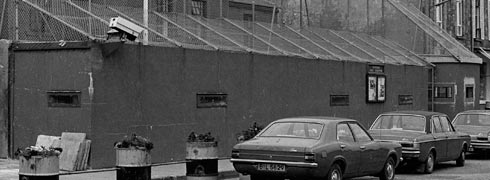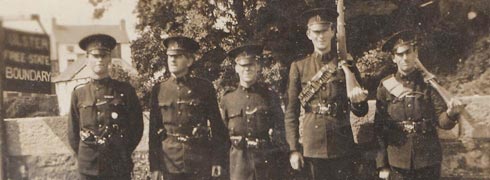About
About the Website
 Funded by the Northern Ireland Community Relations Council, Bicycles, Barracks & Bandoliers explores the history of policing in Ulster from the establishment of the County Constabulary in 1822 to the formation of the Police Service of Northern Ireland (PSNI). This website provides an online museum exhibition which uses artefacts to explore the changing face of policing in the north of Ireland.
Funded by the Northern Ireland Community Relations Council, Bicycles, Barracks & Bandoliers explores the history of policing in Ulster from the establishment of the County Constabulary in 1822 to the formation of the Police Service of Northern Ireland (PSNI). This website provides an online museum exhibition which uses artefacts to explore the changing face of policing in the north of Ireland.
Bicycles, Barracks & Bandoliers features objects from the Police Museum Northern Ireland, the Linenhall Library, the Public Records Office Northern Ireland (PRONI) and the Irish Republican History Museum that reveal the complexities of 195 years of law enforcement in Ulster. Each object is accompanied by contextual images (where relevant) and a written description that demonstrates the item’s use and relevance to the evolution of policing. Related links allow you to view related objects and visit reputable external websites to explore the subject in more detail. The location of each object and its reference number is included to allow you view the artefact in situ. Each object is classified by one of 15 topics which include weapons & armour, women and visual communication, the Topics page contains a full list of all categories. The Links page allows you to explore trustworthy resources that explore broader aspects of law enforcement in more detail. Lists of current policing websites, policing history websites, general history resources and links to legislation and reports of inquiries are provided.
Activities
Bicycles, Barracks & Bandoliers features a number of activities that promote investigation of the history of policing, discussion of the role of policing in the recent Troubles and subsequent peace process and active participation in community policing. The activities are for a general audience and written with reference to the KS3/4 CCEA curriculum. These suggested activities and lesson plans promote debate around the issues of conflict and policing reflecting the KS3 Citizenship Key Concepts of Diversity and Inclusion, Human Rights and Social Responsibility and Democracy and Active Participation. Cross-curricular suggested activities are also highlighted.
Purpose of the website

Bicycles, Barracks & Bandoliers aims to provide a factual and inclusive account of 195 years of policing in the north of Ireland. The recent political conflict in Northern Ireland has resulted in the development of physical and conceptual barriers between the police force and the community it is tasked with policing. Bicycles, Barracks & Bandoliers aims to challenge those preconceptions and go behind the barrack walls to reveal the complex history of policing in the north of Ireland. From the establishment of the County Constabulary in 1822, policing in Ireland has evolved to reflect the great social and political changes in the country such as agrarian unrest, sectarian disorder, civil war, industrialisation, partition, civil rights and political conflict.
Bicycles, Barracks & Bandoliers aims to encourage engagement and participation with the subject of policing. This resource reveals the complexities of policing, acknowledging that there have been both positive and negative aspects of law enforcement in Ireland. The website will demonstrate that a police service protects, as well as prohibits, and that an accountable police force is a necessary part of civil society and every community.
History of Policing

Early Years 1836-86
Sir Robert Peel, future founder of the London Metropolitan Police and prime minister, was chief secretary in Ireland in the early part of the 19th Century. Peel was responsible for establishing the Peace Preservation Force (1814) and later the provincial County Constabulary in 1822. These two forces worked together to control agrarian disturbance and political unrest in Ireland. In 1836 the Peace Preservation Force was disbanded and the county constabularies brought together to form the Irish Constabulary. As well as policing political unrest in Ireland, the Irish Constabulary gradually adopted additional responsibilities. ‘Disposable’ men or plain clothes detectives were introduced in 1840s to investigate serious crime. In 1857, the Irish Revenue Police was disbanded and the Irish Constabulary became responsible for the enforcement of illegal distillation laws. After periods of intense rioting in Belfast in 1864 and Londonderry in 1869, the constabulary replaced the local borough police forces in each district. In 1867, the Irish Constabulary was awarded a Royal prefix by Queen Victoria for their role in the suppression of the Fenian Rising.
Home Rule - Partition 1886-1921
The introduction of the first Home Rule Bill in 1886 caused great political upheaval in Ulster. Sectarian riots broke out in Belfast and 2,000 RIC men, supported by 1,200 troops, were needed to contain the disorder which left 50 people dead. The peaceful period between the mid-1880s and 1916 enabled the RIC to lose most of its military trappings and focus on normal policing duties. The RIC conducted civil responsibilities such as the collection of agricultural statistics and census returns and the enforcement of weights and measures and dog licencing. This left the RIC unprepared for the conflict that characterised Ireland between 1916–1922. When the Irish Republican Army (IRA) declared war on the British security forces during the War of Independence, the RIC bore the brunt of their assaults. Barracks were attacked and patrols ambushed and by December 1919 the force was severely depleted. The British government recruited additional support and the Black and Tans; ex-servicemen and the Auxiliaries; ex-officers were quickly trained and deployed to augment RIC patrols. In the north-east of Ireland the Ulster Special Constabulary (USC) was established to deal with the increase in sectarian attacks, arson and rioting. The Black and Tans and the Auxilairies were disbanded at the end of the War of Independence and the USC continued to act as a reserve force in Northern Ireland. Between 1919 and 1922, 493 members of the RIC and Dublin Metropolitan Police (DMP) died violently and 18 members were declared missing presumed dead. Seventy-seven died as a result of accidents or mistakes associated with fighting and 700 were wounded.
After Partition 1922-68
Under the terms of the Government of Ireland Act 1920, Ireland was partitioned and responsibility for law and order transferred from Britain to the new governments in Belfast and Dublin. In 1922, this led to the disbandment of the RIC and the establishment of two separate police services, the Royal Ulster Constabulary (RUC) in Northern Ireland and the Civic Guard, later An Garda Síochána, in the Irish Free State (IFS). The RUC adopted a similar structure to the RIC and in Northern Ireland, all barracks, vehicles, weapons, equipment and rules and regulations automatically transferred over to the new force. The proportion of Catholics in the new force was set at a third but this target was never met and the percentage declined as former RIC members retired. The RUC was supported by a reserve of Protestant USC, known as B Specials. From 1922–1968, the RUC and USC policed sporadic outbreaks of sectarian unrest, IRA campaigns and World War Two as well as continuing administrative duties of the RIC during times of peace. Border customs and the increase in motorcars resulted in the introduction of a traffic branch and customs post duties. The RUC Women Police Branch was established in 1944 with six recruits under the charge of Women Sergeant MacMillian from the Metropolitan Police. Improvements in radio technology led to a decade of modernization in the RUC in the 1960s. Pocket phones and radio equipped fast response patrol cars made the RUC more efficent but reduced the force’s contact with the public.
The Troubles 1968-98
Throughout 1968-69, the policing of civil rights marches and the resulting disturbances overstretched the RUC and the Army was deployed on the streets of Northern Ireland to restore order. The British army became the main agent of civil power in 1969 and the British government; responsible for law and order, commissioned an inquiry into policing. The Hunt report reccommended that the RUC be disarmed and expanded and the USC be disbanded and advocated the creation of the Ulster Defence Regiment and RUC Reserve. In 1969, the IRA split and the Provisional IRA launched a campagn against the security forces in Northern Ireland. RUC barracks were attacked and stations were increasingly fortified to deal with the escalating PIRA bombings. Policemen were targeted on duty and at home and personal protection weapons and flak jackets were distributed to RUC members. The political conflict gave rise to new Republican and Loyalist paramilitary groups who were responsible for sectarian murders throughout Ulster. Actions such as the introduction of internment increased Catholic resentment against the RUC.
The process of Ulsterisation or police primacy began in the mid-1970s. It aimed to reintroduce the RUC as the main agent for law and order and reduce the number of troops in Northern Ireland. The RUC was expanded and provided with better training, vehicles and equipment including armoured Land Rovers and Federal riot guns. New units such as Headquarters Crime Squad were established and new methods of operation were introduced. Concern over new methods of interogation lead to a government inquiry and changes in procedure. The RUC took over as the prime agent of civil power in 1977 and continued to work with the Army throughout the 1970s and 1980s policing civil unrest and dealing with shootings and increasingly sophisticated bomb attacks. Allegations of a RUC shoot-to kill policy and collusion with paramilitaries were the subject of high-profile inquiries. Changes in the handling of Orange Order marches and the policing of Anglo-Irish Agreement protests caused resentment in Protestant communties and RUC homes came under attack from Loyalists. The IRA and Loyalist Military Command announced ceasefires in 1994, and the RUC began the slow process of normalisation. Troops were withdrawn and fortifications were removed from RUC barracks. Traffic controls and checkpoints were reduced or removed and the RUC began to patrol without flak jackets or heavy weapons. In 1998, after multi-party negotiations the Belfast or Good Friday Agreement was signed. Between 1968-1998, Northern Ireland witnessed thousands of sectarian murders and bomb attacks that disrupted life, damaged property and caused 1,785 civilian and hundreds of security force deaths.
Post-Agreement 1999 - present
Policing played a prominent role in the 1998 Belfast or Good Friday Agreement and a Independent Commission on Policing, lead by Chris Patten, was established. The Patten report, published in 1999, made 175 reccommendations that aimed to progressively transform the paramilitary RUC into a modern, community-based Police Service. Reccommendations included the introduction of a Policing Board, District Policing Partnerships and a change of name, badge and oath. Political reaction was mixed but the majority of Patten’s recommendations were enacted in the Police (Northern Ireland) Act 2000. In April 2000, the Queen awarded the George Cross to the RUC in recognition of their bravery during 30 years of conflict. In 2001, the RUC became the Police Service of Northern Ireland (PSNI). Patten’s reccommendations continued to be implemented throughout 2000–2010. The GAA revoked its Rule 21, which had prevented members of the British security forces playing Gaelic games, and the PSNI GAA team was established. Catholic recruitment was increased and the SDLP and Sinn Féin joined the Policing Board. PSNI stations were made visible from the street and less forbidding in appearance. PSNI increased their neighbourhood policing duties and returned to patrolling on bicycles. The number of female recruits in the police force increased and in 2014, Judith Gillespie became the first female deputy chief constable.
`